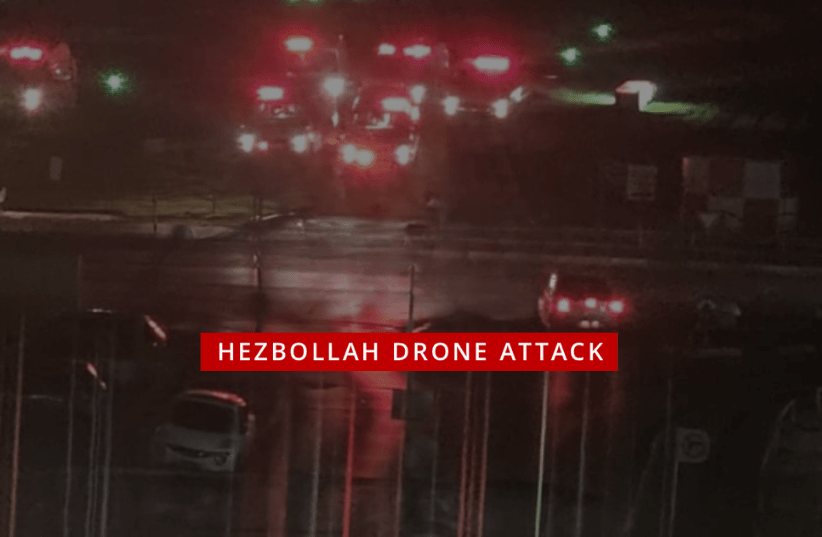|
Getting your Trinity Audio player ready...
|
Hezbollah Drone Strike in Northern Israel Leaves 67 Injured; Marking the Deadliest Attack Since October 7
Edited by: Fern Sidman
Four IDF soldiers were killed and another seven were seriously wounded in Hezbollah’s drone attack targeting a military base near Binyamina, the IDF reported on Sunday night.
All wounded soldiers were evacuated to hospitals for further medical treatment, and notifications were sent to the families of both dead and wounded.
A devastating drone strike launched by Hezbollah in Lebanon into northern Israel has resulted in dozens of casualties, marking the highest number of injuries in a single incident since the October 7 massacre. The attack, which took place in Binyamina, north of Netanya caused widespread devastation and has raised concerns over the increasing use of drones by Hezbollah to target Israeli civilians and infrastructure. According to a report on Ynet News, at least 67 people were injured in the strike, with four in critical condition and five others seriously wounded. Many of the injured were transported to hospitals across northern Israel, including Rambam Hospital in Haifa and Sheba Hospital in Tel Hashomer.
A #Hezbollah drone strike on a military base near Binyamina – south of #Haifa #Israel 🇮🇱
The drone hit the dining room of the base that was packed with soldiers
Emergency services rush to the rescue amidst chaotic scenes. Among the 25 wounded – three are critical and five… pic.twitter.com/KfQFD5NCHu
— Shafek Koreshe (@shafeKoreshe) October 13, 2024
Magen David Adom (MDA), Israel’s national emergency medical service, quickly responded to the attack, deploying teams to the site. MDA Director General Eli Bin confirmed that 39 casualties were evacuated by MDA ambulances, while military and other emergency services transported an additional 25 injured individuals. Ynet News reported that the sheer scale of the attack led Emek Medical Center in Afula to declare a mass-casualty event. Helicopters were also utilized to airlift some of the more severely injured to hospitals, further underscoring the urgency of the situation.
Cleared for publication: Four IDF soldiers were killed in the Hezbollah drone strike near Binyamina. 💔
“Through their passing, they bequeathed us the gift of life.”
Never forget.🕯 pic.twitter.com/uHBhPUtpn4
— Nazi Hunters (@HuntersOfNazis) October 13, 2024
Hezbollah, the Iranian-backed terrorist group based in Lebanon, claimed responsibility for the drone attack, stating that it was a direct response to recent Israeli Defense Forces (IDF) strikes in Lebanon, particularly those in the capital city of Beirut. Ynet News also reported that the attack involved two drones launched from Lebanon into Israeli airspace. The first drone was intercepted by Israeli air defense systems after alarms were triggered in the Western Galilee, including in cities such as Acre and Nahariya. However, the second drone managed to penetrate deep into Israel, reaching the Binyamin area without triggering any warning systems before it exploded.
Footage from Israel reveals significant IDF casualties after a surprise drone strike by Hezbollah on a military base.
The U.S. has already deployed troops and advanced air defense systems to bolster Israel’s defense against further attacks.
Meanwhile, Israel is preparing for a… pic.twitter.com/gL2kMPszUm
— Shadow of Ezra (@ShadowofEzra) October 13, 2024
Eyewitnesses described the scene as chaotic and terrifying. “There was a crazy boom, without any warning,” one witness told Ynet News, highlighting the shock and confusion that followed the unexpected attack. The lack of an alarm ahead of the drone’s explosion is now under investigation by the IDF.
The IDF is now looking into why the air defense systems failed to intercept the second drone and why no alarm was sounded to warn civilians in the affected area. This security lapse has raised concerns about Israel’s ability to defend against drone strikes in the increasingly volatile northern region.
The Hezbollah drone that interrupted dinner, lighting up an entire company of te***rists managed to evade all air defences and impact without being detected! #Israel pic.twitter.com/wQhh5epcGB
— AW Angry Warhawk (@Hadrian130AD) October 13, 2024
Israeli media has reported that Hezbollah used fiber-optic drones, a technology primarily employed by Russia in its war on Ukraine. These drones are undetectable by radars and hard to intercept, posing a significant threat to Israel’s defenses.
Less than an hour after the initial strike, the Israeli Air Force intercepted another UAV launched from Lebanon in the northern naval area, according to the IDF. While this subsequent interception prevented further damage, the success of Hezbollah’s earlier drone attack highlights the growing threat posed by the group’s drone capabilities.
Mass casualty event following a Hezbollah drone strike on an IDF base. At least 67 Israelis are injured, 5 are in critical condition. pic.twitter.com/bLu3xwM6iL
— Aviva Klompas (@AvivaKlompas) October 13, 2024
Medical teams have been working around the clock to treat the wounded, many of whom sustained serious injuries in the blast. Ynet News reported that helicopters were deployed to quickly evacuate some of the most critically injured to major medical centers, illustrating the extensive medical response required to deal with the attack.
Hezbollah’s drone strike comes amid heightened tensions between Israel and Lebanon, particularly after recent IDF strikes targeting Hezbollah positions in southern Lebanon and Beirut. Ynet News reported that Hezbollah specifically cited the killing of Hezbollah leader Hassan Nasrallah and other top officials in Israeli airstrikes as a justification for the drone strike, further intensifying the cross-border hostilities.
A Hezbollah source quoted by Al-Jazeera said, “Hezbollah’s capabilities are still strong and capable of reaching deep into Israel,” underscoring the terror group’s growing reliance on UAVs as a key weapon in their ongoing conflict with Israel.
Israeli media reports – Hezbollah used fiber-optic drones, a technology primarily employed by Russia in Ukraine
These drones are undetectable by radars hard to intercept, posing a significant threat to Israel’s defenses. @Israel #Hezbollah #fiberoptic #DroneAttacks… pic.twitter.com/icKKaZPRDR— The Jewish Voice (@TJVNEWS) October 13, 2024
The UAV attack was part of a broader offensive that involved launching the drones under the cover of a rocket barrage aimed at the Galilee region in northern Israel, according to the Arabic-language Sky News network. The UAV penetrated Israeli airspace and launched a missile before exploding, as reported by Al-Hadath, a Saudi news channel. These claims highlight Hezbollah’s increasingly sophisticated use of drones, which have become a central tool in their military strategy against Israel.
This is not the first time Hezbollah has used UAVs equipped with missiles to target Israel. As Ynet News reported, in May 2023, Hezbollah claimed responsibility for an attack in the Metula region, where a UAV equipped with S5 missiles was used to strike Israeli targets before the drone itself exploded. The terror group’s continued use of UAVs poses a significant challenge to Israeli defense systems, which are struggling to keep pace with this growing threat.
Hezbollah’s statement following the recent attack emphasized their ability to protect Lebanon and its people, framing the assault as part of their defensive strategy. However, the scale and sophistication of their UAV strikes suggest a broader offensive strategy aimed at testing Israel’s defenses and exerting pressure on northern Israeli communities. The ongoing barrage of rocket and drone attacks has taken a heavy toll on Israeli civilians, as Hezbollah intensifies its military operations while Israel conducts limited ground operations in southern Lebanon.
🇮🇱 The first moments after the drone strike in the dining hall of the Israeli military base#Israel #Lebanon #Hezbollah #HIZBULLAH pic.twitter.com/2bK4PaSzls
— Intelligence FRONT (@intelligencefnt) October 13, 2024
The attack comes in the wake of several other serious incidents caused by Hezbollah’s ongoing barrage of rockets and UAV strikes on Israeli communities. Ynet News reported that earlier in the week, two Israeli civilians, Dvir Sharvit, 43, and Revital Yehud, 45, were killed in Kiryat Shmona after a direct hit from a Hezbollah rocket. These fatalities underscore the increasing threat posed to Israeli civilians living near the northern border, where Hezbollah has concentrated many of its attacks.
Israel has been grappling with the UAV threat for months, and the most recent attack is a stark reminder of the challenges the country faces in neutralizing these drones. On the eve of Yom Kippur, a UAV launched from Lebanon struck a sheltered housing facility for the elderly in Herzliya. Fortunately, there were no casualties in this incident, thanks to the residents’ adherence to Home Front Command directives. However, Ynet News reported that this direct hit, even on a civilian target, highlights the vulnerability of Israeli infrastructure to Hezbollah’s increasingly sophisticated drone tactics.
The 🇮🇱 Israel Defense Forces have issued an initial statement after a Hezbollah drone strike targeted a military base in northwestern Israel tonight.
The attack resulted in the deaths of four Israeli soldiers, with seven others sustaining severe injuries.
Authorities are…
— Paulo Aguiar (@padejesar) October 13, 2024
The use of UAVs has added a new dimension to the conflict between Hezbollah and Israel, complicating the IDF’s ability to protect civilian populations and critical infrastructure. The ability of Hezbollah to launch missile-equipped UAVs from Lebanon into Israeli airspace—coupled with the group’s continued rocket fire—has tested Israel’s air defense systems. As Ynet News pointed out, Israel has experienced several incidents where drones have evaded detection or interception, leading to direct hits on civilian targets.
According to an initial investigation reported by The Times of Israel, Hezbollah deployed two drones, known as Mirsad drones. The Mirsad drone, also known in Iran as the Ababil-T, is Hezbollah’s primary suicide drone. The model is widely believed to have been developed with Iranian support and is a critical component of Hezbollah’s aerial capabilities, as was reported by The Times of Israel.
According to the Alma Center, an Israeli security research institute that focuses on threats from the north, the Mirsad drone is highly advanced for a terror organization such as Hezbollah. It boasts a 120-kilometer assault range, a top speed of 370 kilometers per hour, and the capacity to carry up to 40 kilograms of explosives. Additionally, the drone can fly at altitudes of up to 3,000 meters, making it a versatile and dangerous weapon in Hezbollah’s arsenal.
Israeli helicopters and aircraft pursued the second Mirsad drone, but it quickly disappeared from radar, likely due to its low altitude flight pattern. Flying close to the ground is a known tactic used to evade radar detection, and it appears this strategy worked in Hezbollah’s favor during the attack. According to The Times of Israel, Israeli forces initially assumed the drone had either crashed or been intercepted, leading to no sirens being sounded in the Binyamina area. Unfortunately, this assumption proved to be incorrect, and the drone ultimately detonated, causing significant casualties.
Hezbollah claims responsibility for a drone strike on an Israeli military camp in Binyamina. 3 dead, 67 injured, including 4 critically#Israel #Lebanon #Hezbollah #MiddleEastCrisis
— Dr. D. Bahuguna (@bahugunadalai) October 13, 2024
The use of Mirsad drones represents a significant escalation in Hezbollah’s ongoing campaign against Israel. These drones are not just simple reconnaissance tools but are designed specifically for suicide missions. The Mirsad’s ability to carry a payload of 40 kilograms of explosives, combined with its speed and range, makes it a highly effective weapon for targeting critical infrastructure or populated areas. According to the Alma Center’s analysis, the drone’s capabilities allow it to strike targets deep within Israeli territory, posing a severe challenge to Israel’s air defense systems.
Hezbollah’s increasing reliance on drones, particularly advanced models like the Mirsad, is part of a broader strategy to leverage Iranian technology and military expertise. Iran has long been a supporter of Hezbollah, providing both financial backing and weapons technology, including UAVs (unmanned aerial vehicles) like the Ababil-T. These drones give Hezbollah a low-cost, highly destructive means of targeting Israel without putting its fighters directly in harm’s way.
Hezbollah’s use of drones marks a new front in the asymmetric warfare it has waged against Israel for decades. Unlike traditional rocket attacks, which are easier to track and intercept, drones can bypass certain air defense measures by flying low and evading radar. The Mirsad drones used in this attack, with their Iranian backing, show the evolving nature of Hezbollah’s military capabilities and the growing complexity






